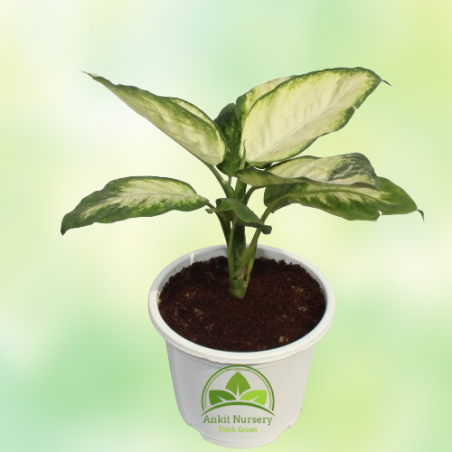
- -10%






It appears you may be referring to the "Dieffenbachia" plant, often misspelled as "Dieffenbachia bachia." Dieffenbachia is a popular and attractive houseplant known for its lush foliage. Dieffenbachia prefers bright, indirect light but can tolerate lower light conditions. Avoid direct sunlight, as it can scorch the leaves.
Keep the soil consistently moist but not waterlogged. Water the plant when the top inch of soil feels dry to the touch, and allow any excess water to drain away. Avoid letting the soil dry out completely between waterings. Use well-draining potting soil. A mix formulated for houseplants or tropical plants works well. Ensure the pot has drainage holes to prevent water from accumulating at the roots.
Dieffenbachia prefers temperatures between 65-80°F (18-27°C). Protect it from cold drafts, as they can cause leaf damage. Dieffenbachia appreciates moderate to high humidity levels. You can increase humidity by misting the leaves regularly or placing a tray of water and pebbles near the plant. Feed your Dieffenbachia with a balanced liquid fertilizer diluted to half strength every 4-6 weeks during the growing season (spring and summer). Reduce or stop fertilization in fall and winter when growth slows down.
Prune your Dieffenbachia as needed to remove any dead or yellowing leaves and to maintain its shape. Wear gloves when pruning, as the sap can irritate the skin. Repot your Dieffenbachia every few years to refresh the soil and provide room for root growth. Choose a pot that is slightly larger than the current one, with drainage holes. Dieffenbachia plants are toxic if ingested, so keep them out of reach of children and pets. Wash your hands after handling the plant.
Place the plant near a window where it can receive filtered sunlight or artificial light. With proper care, your Dieffenbachia can thrive and add beauty to your indoor space. Enjoy its lush foliage and vibrant green leaves!
Red Sensation Cordyline, also known as Cordyline fruticosa 'Red Sensation' or Red Sensation...
Peace Lily (Spathiphyllum spp.) is a popular and widely grown houseplant known for its...
Snake Plant Dracaena Trifasciata scientifically known as Sansevieria trifasciata, is not a...
The "Golden Xanadu" is a cultivar of the Philodendron plant, known scientifically as...
Syngonium Golden Plant is a cultivar of Syngonium podophyllum, commonly known as arrowhead...
Aglaonema Snow White is a specific cultivar of Aglaonema known for its striking foliage. As...
Ferns are a diverse group of plants known for their delicate, feathery foliage and are...
Pedilanthus tithymaloides, commonly known as Devil's Backbone or Redbird Cactus, is a...
Cyperus alternifolius, commonly known as Umbrella Palm, is a popular plant species native to...
Indoor plants are a great way to bring nature into your home, purify the air, and enhance your...
"Dracaena Red" is not a specific species of Dracaena but likely refers to a variety of...
The Snowflake Aralia Plant, also known as Aralia or Parsley Aralia, is a tropical plant with...
Aglaonema, commonly known as Chinese evergreen, is a popular indoor plant appreciated for its...
Philodendron xanadu is indeed a delightful cultivar known for its lush and tropical...
The Dracaena Compacta, also known as Dracaena deremensis 'Compacta' or Dwarf Dracaena, is a...
The Dracaena Rosea, also known as the Pink Dracaena or Pink Madagascar Dragon Tree, is a...